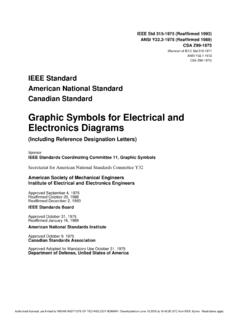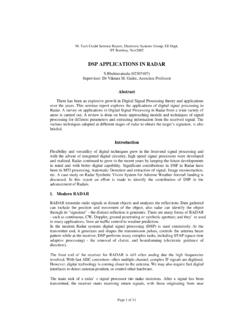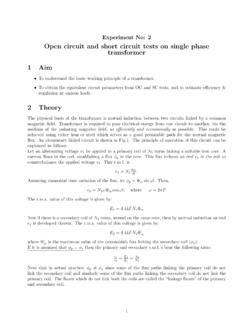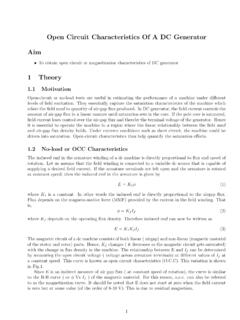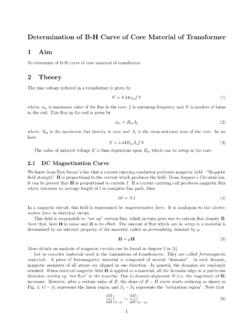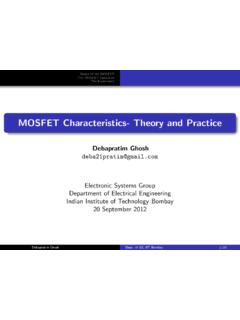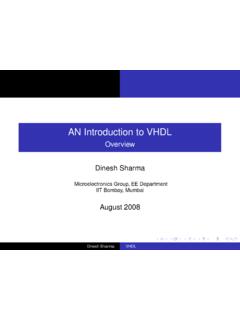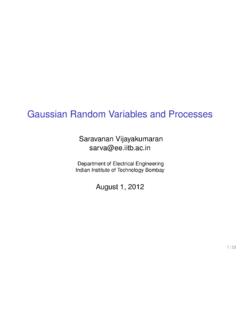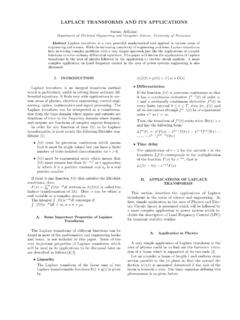Transcription of EE101: RLC Circuits (with DC sources)
1 EE101: RLC Circuits (with DC sources) M. B. of Electrical EngineeringIndian Institute of Technology BombayM. B. Patil, IIT BombaySeriesRLCcircuitRLiCVRVCVLV0 KVL:VR+VL+VC=V0 i R+Ldidt+1 CZi dt=V0 Differentiating w. r. , we get,Rdidt+Ld2idt2+1Ci= ,d2idt2+RLdidt+1 LCi= 0 ,a second-order ODE with constant B. Patil, IIT BombaySeriesRLCcircuitRLiCVRVCVLV0 KVL:VR+VL+VC=V0 i R+Ldidt+1 CZi dt=V0 Differentiating w. r. , we get,Rdidt+Ld2idt2+1Ci= ,d2idt2+RLdidt+1 LCi= 0 ,a second-order ODE with constant B. Patil, IIT BombaySeriesRLCcircuitRLiCVRVCVLV0 KVL:VR+VL+VC=V0 i R+Ldidt+1 CZi dt=V0 Differentiating w. r. , we get,Rdidt+Ld2idt2+1Ci= ,d2idt2+RLdidt+1 LCi= 0 ,a second-order ODE with constant B. Patil, IIT BombaySeriesRLCcircuitRLiCVRVCVLV0 KVL:VR+VL+VC=V0 i R+Ldidt+1 CZi dt=V0 Differentiating w.
2 R. , we get,Rdidt+Ld2idt2+1Ci= ,d2idt2+RLdidt+1 LCi= 0 ,a second-order ODE with constant B. Patil, IIT BombayParallelRLCcircuitCRLiRiLVI0iCKCL: iR+iL+iC=I0 1RV+1 LZV dt+CdVdt=I0 Differentiating w. r. , we get,1 RdVdt+1LV+Cd2 Vdt2= ,d2 Vdt2+1 RCdVdt+1 LCV= 0 ,a second-order ODE with constant B. Patil, IIT BombayParallelRLCcircuitCRLiRiLVI0iCKCL: iR+iL+iC=I0 1RV+1 LZV dt+CdVdt=I0 Differentiating w. r. , we get,1 RdVdt+1LV+Cd2 Vdt2= ,d2 Vdt2+1 RCdVdt+1 LCV= 0 ,a second-order ODE with constant B. Patil, IIT BombayParallelRLCcircuitCRLiRiLVI0iCKCL: iR+iL+iC=I0 1RV+1 LZV dt+CdVdt=I0 Differentiating w. r. , we get,1 RdVdt+1LV+Cd2 Vdt2= ,d2 Vdt2+1 RCdVdt+1 LCV= 0 ,a second-order ODE with constant B. Patil, IIT BombayParallelRLCcircuitCRLiRiLVI0iCKCL: iR+iL+iC=I0 1RV+1 LZV dt+CdVdt=I0 Differentiating w.
3 R. , we get,1 RdVdt+1LV+Cd2 Vdt2= ,d2 Vdt2+1 RCdVdt+1 LCV= 0 ,a second-order ODE with constant B. Patil, IIT BombaySeries/ParallelRLCcircuitsRLCiCRLi RiLVRVCViCVLI0V0*A series RLC circuit driven by a constant current source is trivial to the current through each element is known, the voltage can be found in astraightforward R,VL=Ldidt,VC=1 CZi dt.*A parallel RLC circuit driven by a constant voltage source is trivial to the voltage across each element is known, the current can be found in astraightforward ,iC=CdVdt,iL=1 LZV dt.*The above equations hold even if the applied voltage or current is not constant,and the variables of interest can still be easily obtained without solving adifferential B. Patil, IIT BombaySeries/ParallelRLCcircuitsRLCiCRLi RiLVRVCViCVLI0V0*A series RLC circuit driven by a constant current source is trivial to the current through each element is known, the voltage can be found in astraightforward R,VL=Ldidt,VC=1 CZi dt.
4 *A parallel RLC circuit driven by a constant voltage source is trivial to the voltage across each element is known, the current can be found in astraightforward ,iC=CdVdt,iL=1 LZV dt.*The above equations hold even if the applied voltage or current is not constant,and the variables of interest can still be easily obtained without solving adifferential B. Patil, IIT BombaySeries/ParallelRLCcircuitsRLCiCRLi RiLVRVCViCVLI0V0*A series RLC circuit driven by a constant current source is trivial to the current through each element is known, the voltage can be found in astraightforward R,VL=Ldidt,VC=1 CZi dt.*A parallel RLC circuit driven by a constant voltage source is trivial to the voltage across each element is known, the current can be found in astraightforward ,iC=CdVdt,iL=1 LZV dt.
5 *The above equations hold even if the applied voltage or current is not constant,and the variables of interest can still be easily obtained without solving adifferential B. Patil, IIT BombaySeries/ParallelRLCcircuitsRLCiCRLi RiLVRVCViCVLI0V0*A series RLC circuit driven by a constant current source is trivial to the current through each element is known, the voltage can be found in astraightforward R,VL=Ldidt,VC=1 CZi dt.*A parallel RLC circuit driven by a constant voltage source is trivial to the voltage across each element is known, the current can be found in astraightforward ,iC=CdVdt,iL=1 LZV dt.*The above equations hold even if the applied voltage or current is not constant,and the variables of interest can still be easily obtained without solving adifferential B.
6 Patil, IIT BombaySeries/ParallelRLCcircuitsRLCiCRLi RiLVRVCViCVLI0V0*A series RLC circuit driven by a constant current source is trivial to the current through each element is known, the voltage can be found in astraightforward R,VL=Ldidt,VC=1 CZi dt.*A parallel RLC circuit driven by a constant voltage source is trivial to the voltage across each element is known, the current can be found in astraightforward ,iC=CdVdt,iL=1 LZV dt.*The above equations hold even if the applied voltage or current is not constant,and the variables of interest can still be easily obtained without solving adifferential B. Patil, IIT BombaySeries/ParallelRLCcircuitsRLCiCRLi RiLVRVCViCVLI0V0*A series RLC circuit driven by a constant current source is trivial to the current through each element is known, the voltage can be found in astraightforward R,VL=Ldidt,VC=1 CZi dt.
7 *A parallel RLC circuit driven by a constant voltage source is trivial to the voltage across each element is known, the current can be found in astraightforward ,iC=CdVdt,iL=1 LZV dt.*The above equations hold even if the applied voltage or current is not constant,and the variables of interest can still be easily obtained without solving adifferential B. Patil, IIT BombaySeries/ParallelRLCcircuitsA generalRLCcircuit (with one inductor and one capacitor) also leads to asecond-order ODE. As an example, consider the following circuit:iCLVR2V0R1V0=R1i+Ldidt+V(1)i=CdV dt+1R2V(2)Substituting (2) in (1), we getV0=R1 CV +V/R2 +L CV +V /R2 +V,(3)V [LC] +V [R1C+L/R2] +V[1 +R1/R2] =V0.(4)M. B. Patil, IIT BombaySeries/ParallelRLCcircuitsA generalRLCcircuit (with one inductor and one capacitor) also leads to asecond-order ODE.
8 As an example, consider the following circuit:iCLVR2V0R1V0=R1i+Ldidt+V(1)i=CdV dt+1R2V(2)Substituting (2) in (1), we getV0=R1 CV +V/R2 +L CV +V /R2 +V,(3)V [LC] +V [R1C+L/R2] +V[1 +R1/R2] =V0.(4)M. B. Patil, IIT BombaySeries/ParallelRLCcircuitsA generalRLCcircuit (with one inductor and one capacitor) also leads to asecond-order ODE. As an example, consider the following circuit:iCLVR2V0R1V0=R1i+Ldidt+V(1)i=CdV dt+1R2V(2)Substituting (2) in (1), we getV0=R1 CV +V/R2 +L CV +V /R2 +V,(3)V [LC] +V [R1C+L/R2] +V[1 +R1/R2] =V0.(4)M. B. Patil, IIT BombaySeries/ParallelRLCcircuitsA generalRLCcircuit (with one inductor and one capacitor) also leads to asecond-order ODE. As an example, consider the following circuit:iCLVR2V0R1V0=R1i+Ldidt+V(1)i=CdV dt+1R2V(2)Substituting (2) in (1), we getV0=R1 CV +V/R2 +L CV +V /R2 +V,(3)V [LC] +V [R1C+L/R2] +V[1 +R1/R2] =V0.
9 (4)M. B. Patil, IIT BombayGeneral solutionConsider the second-order ODE with constant coefficients,d2ydt2+adydt+b y=K(constant).The general solutiony(t) can be written as,y(t) =y(h)(t) +y(p)(t),wherey(h)(t) is the solution of the homogeneous equation,d2ydt2+adydt+b y= 0,andy(p)(t) is a particular constant, a particular solution is simplyy(p)(t) = the context ofRLCcircuits,y(p)(t) is the steady-state value of the variable ofinterest, ,y(p)= limt y(t),which can be often found by B. Patil, IIT BombayGeneral solutionConsider the second-order ODE with constant coefficients,d2ydt2+adydt+b y=K(constant).The general solutiony(t) can be written as,y(t) =y(h)(t) +y(p)(t),wherey(h)(t) is the solution of the homogeneous equation,d2ydt2+adydt+b y= 0,andy(p)(t) is a particular constant, a particular solution is simplyy(p)(t) = the context ofRLCcircuits,y(p)(t) is the steady-state value of the variable ofinterest, ,y(p)= limt y(t),which can be often found by B.
10 Patil, IIT BombayGeneral solutionConsider the second-order ODE with constant coefficients,d2ydt2+adydt+b y=K(constant).The general solutiony(t) can be written as,y(t) =y(h)(t) +y(p)(t),wherey(h)(t) is the solution of the homogeneous equation,d2ydt2+adydt+b y= 0,andy(p)(t) is a particular constant, a particular solution is simplyy(p)(t) = the context ofRLCcircuits,y(p)(t) is the steady-state value of the variable ofinterest, ,y(p)= limt y(t),which can be often found by B. Patil, IIT BombayGeneral solutionConsider the second-order ODE with constant coefficients,d2ydt2+adydt+b y=K(constant).The general solutiony(t) can be written as,y(t) =y(h)(t) +y(p)(t),wherey(h)(t) is the solution of the homogeneous equation,d2ydt2+adydt+b y= 0,andy(p)(t) is a particular constant, a particular solution is simplyy(p)(t) = the context ofRLCcircuits,y(p)(t) is the steady-state value of the variable ofinterest, ,y(p)= limt y(t),which can be often found by B.
